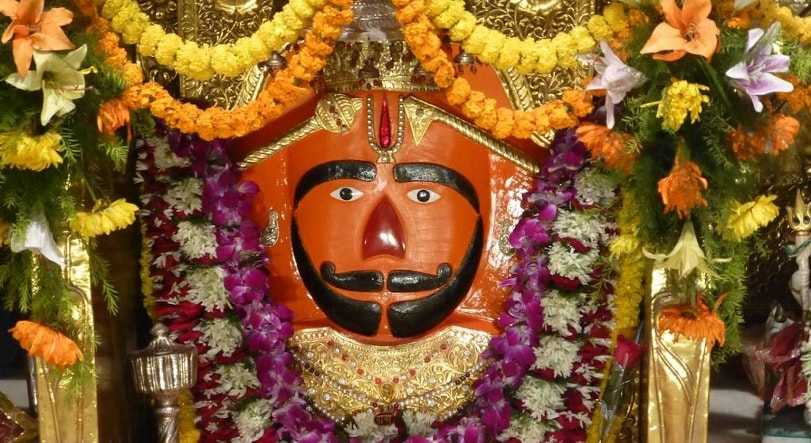
History of Salasar Dham
There are several stories behind the origins of the swayambhu Salasar Balaji. The most popular one narrates that on one Saturday of-of Shraavana Shukla Navami samvat 1811 (1754 AD), a jat farmer in Asia village was ploughing his field when a miracle happened. While doing that his plough suddenly struck a stone-like that created a resonating sound. On further examination, he found a sand covered idol and showed it to his wife. The idol was of a bearded and moustached Hanuman. Soon enough the news of this discovery spread far and wide and reached the Thakur of Asota. That night itself Balaji appeared in Thakur's dreams and demanded the idol to be sent to Salasar. Same night another devotee of the lord had the same dream and was asked to consecrated at the place of the idol.
A slightly varying story narrates that after Thakur had the divine dream, he bought two bulls, and kept the idol in the cart. After that, he let the bulls roam around and decided to build a temple wherever they stopped. The place where the bulls stopped was given the name Salasar, and a temple was constructed for the idol in 1754 AD.
Architecture of Salasar Dham
The Salasar Dham temple was created after a divine dream in which Balaji himself commanded Mohandas Maharaj to construct a temple for his idol. He built an initial mud-stone temple with the help of Muslim artisans Noora and Dau of Fatehpur Shekhawat. The temple was later rebuilt in concrete with the help of the successor of Sikar Jagirdar Rao Devi Singh. Later, Mohandas' descendants Kaniram and Ishwardas developed and renovated the temple and gave it the present form of a giant temple complex.
It took 2 years to construct the mighty temple using bricks, stones, cement, lime mortar, and white marble. The Sabha Mandap (prayer hall) and the Sanctum Sanctorum (garbha griha) are covered with artistic works of gold and silver, and the parikrama path is made from white marble. Various utensils used in puja, doors and vestibule are also made up of silver. The Sanctum Santorum has beautiful floral decoration and mosaic works both done in gold and silver.
The temple is administered and maintained by the trust Hanuman Sewa Samiti, and the everyday puja is done by the Brahmin priest of the Dadhich clan. Management of fairs, social works, public and private facilities such as the maintenance of the road, water supply, charitable hospitals, in the village is also looked after by Hanuman Sewa Samiti.
Rituals at Salasar Dham
Coconut Tying
It is a popular belief among the devotees that tying a coconut with a moli (sacred red threads) in the temple premises helps fulfil their wishes. The practice was initiated by the Jagirdar of Sikar, Rao Raja Devi Singh. He tied a coconut in the temple and wished for the birth of a son. Within 10 months he was blessed with a son and thus the tradition of tying coconut began.
Savamani
Another widely practised custom is offering savamani (about 50 kg) food to the deity. Earlier the food was prepared by the temple cooks, but as the traffic increased, the job was also outsourced to several independent shopkeepers & food-caterers. Several delicacies like Dal, Baati, Churma, Boondi, Peda & Laddu is prepared for bhog (food for deity). The food is first offered to the deity and is later distributed among the devotees and the needy.
Salasar Balaji
Salasar Hanuman/Balaji is regarded as one of the holy trios that include Rani Sati and Khatushyamji and receives great veneration from all the devotees. Of all the idols of the deity found in India, Salasar Balaji is considered the unique because of its round, bearded face with a moustache. Apart from that, the idol is swyambhu, which means that it was not handcrafted by any person, but was created of its own accord. Because of the self-manifestation of the holy idol, the temple is considered a shakti sthal, or a place of power and is famed as the grantee of all earthly wishes. It is also said that the drinking water in the wells of the town is because of the grace and blessings of Salasar Hanuman.
Best time to visit Salasar Dham
While you can visit the temple anytime during the year, it is best to avoid the summer months because of scorching heat. Visit the temple during the festivals and fairs to enjoy to the fullest.
How to Reach Salasar Dham
The 165 Km drive from Jaipur takes approximately two & a half hours via the national highway. It is also in close proximity to Sikar (57 Km), Lakshmangarh (31 Km) and Sujangarh (27 Km).
Top Tourist Places in Churu
Salasar Dham
Tal Chappar Sanctuary
All Tourist Places in Churu
Tips
1. The celebration of various festivals and fairs like Sri Hanuman Jayanti, Ashvin Shukla Chaturdashi and Purnima and Bhaadra Shukla Chaturdashi and Purnima are done grandly. So, you can plan your visit during this time.2. While the temple is open for almost the whole day, it is best to visit during the morning or evening aarti.3. Photography is strictly prohibited inside the prayer hall.4. Don't miss the regular recitations of Ramayan, kirtan and bhajans at the temple premises. A melodious recitation of sundarkand is done on every Tuesday in union by the singers.5. During the festivals and the fairs the place becomes very crowded. So, it is best to book the hotels/dharamshalas in advance for such visits.
Photos of Salasar Dham
Comments on Salasar Dham
Post Your Comment






